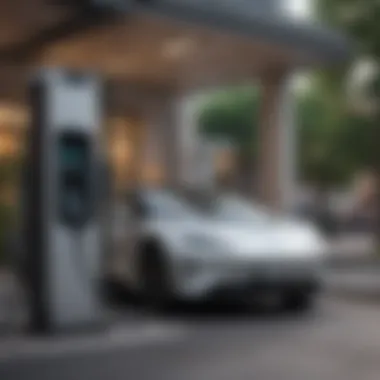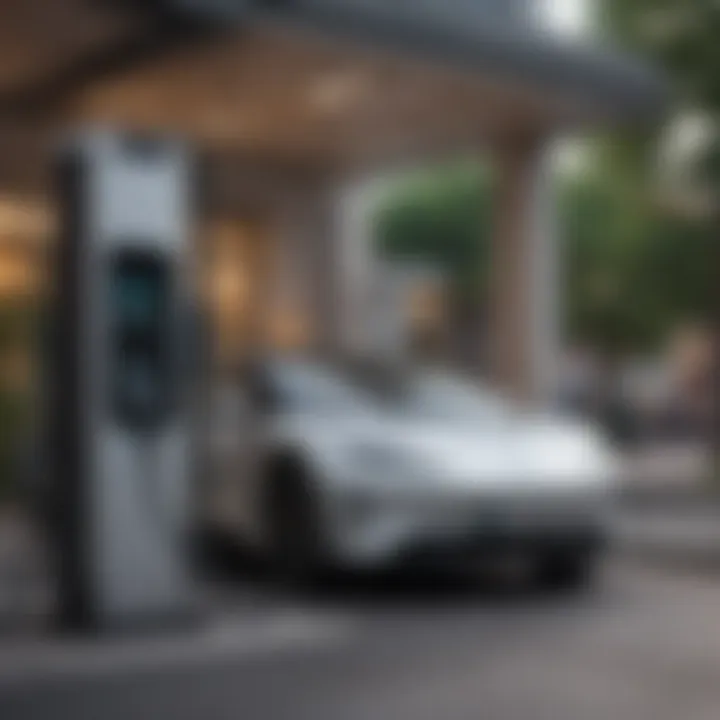Can Electric Cars Run on Gas? A Deep Dive Analysis


Intro
In recent years, the automotive landscape has seen a significant shift towards electric mobility. As the conversation around sustainable transportation continues to evolve, many are left wondering about the relationship between electric vehicles and traditional gasoline systems. Can electric cars effectively run on gas? This critical question leads us to explore the intricate world of hybrid technologies, operational mechanisms, and the future of motor vehicles in a context dependent on more environmentally sustainable choices.
Car Reviews
Overview of the Vehicle
Electric cars differ markedly from conventional gas-powered vehicles. The essence of their operation lies primarily in electric motors powered by rechargeable battery packs. However, with advancements in technology, some vehicles merge these electric systems with gasoline engines, giving birth to hybrid automobiles. This enables a dual method of propulsion, which can optimize performance while lessening reliance on any single fuel type.
Performance Analysis
Performance, when talking about hybrid vehicles, encompasses various metrics such as acceleration, fuel efficiency, and handling. Typical hybrids, like the Toyota Prius, operate predominantly on electric power as long as battery charge permits. Upon depleting the battery, the gasoline engine activates, allowing continued journey. While certain electric vehicles thrive around urban settings, hybrid structures offer an elevated range and efficiency for long drives. The peak torque of electric motors allows these vehicles to achieve brisk speeds unexpectedly.
Design and Interior Features
In terms of design, many hybrid vehicles showcase a blend between traditional and modern aesthetics. Interior layouts typically leverage technology to provide drivers with robust digital interfaces presenting vital information such as electric range, fuel usage, and power distribution. Manufacturers invest in high-quality materials and ergonomic designs to cater to discerning tastes while ensuring comfort for extended drives.
Safety Ratings and Specifications
Safety features of electric and hybrid models now rival those of internal combustion engine vehicles. Various institutes assess vehicles rigorously, and many hybrids achieve commendable ratings. Standard features include electronic stability control, advanced airbag systems, and camera-assisted driving aids, underscoring a commitment to maintaining high standards in passenger safety.
Value for Money
From a pricing standpoint, hybrids often sit at a higher price point than their purely gas-driven cousins owing to their complex systems and technology. Nevertheless, the fuel savings and incentives from local governments can offset initial high cost over time. This financial aspect plays a substantial role in decision-making processes for prospective buyers sidelining traditional fuels.
Automotive Industry Trends
Emerging Technologies
Technological advancement shapes not just hybrids, but the future of the automotive industry. Electric powertrains are increasingly common, with new materials enhancing energy storage and retrieval efficiencies. Developments in battery technology focus on boosting efficiency, sustainability, and extending range, fulfilling consumer desires for longer trips without robust charging infrastructure.
Changes in Consumer Preferences
There is an unmistakable shift in consumer sentiment towards energy efficiency and lower emissions. Studies suggest that more buyers importantly consider ecological impacts when selecting vehicles, which in turn drives business strategy. Enterprises are no longer merely producing cars but attempting to meet an ever-changing environmental consciousness.
Sustainability and Eco-Friendly Practices
Corporations are including sustainability reporting in day-to-day operations. This can take the form of using recycled materials in vehicle components or updating factories to reduce environmental effects. Such measures appeal to a consumer base that values corporate responsibility.
Future of Electric Vehicles
The horizon indicates that fully electric models and hybrids will gradually blur lines in terms of market share. Rapid advancements hint that pure electric cars will capture a more substantial amount as charging infrastructures expand and battery technologies progress.
Industry Challenges and Solutions
Challenges such as battery disposal, sourcing raw materials ethically, and evolving legislative frameworks pose potential stumbling blocks. Solutions include using sustainable suppliers, exploring recycling options, and adapting operations in real-time to respond to regulations. As these prblems are satisifed, hybrids could ultimately help develop technologies that respect consumer choices while also considering ecological implications.
Understanding the integration of electric and gasoline technologies within vehicles becomes essential in navigating options for future mobility.
By examining these elements, we set the stage for a deeper exploration into hybrid vehicle dynamics and their evolving role in the automotive universe.
Understanding Electric Vehicles
The significance of understanding electric vehicles lies in their growing presence in today’s automotive landscape. As technologies advance, electric vehicles (EVs) represent a shift from traditional gasoline engines. This evolution sparks inquiries into operational mechanics and environmental implications.
Electric vehicles operate differently from conventional vehicles. The mechanics involve components like electric motors and batteries. Recognizing the nuances in functioning fosters informed discussions on hybrid technologies, energy consumption, and emissions.
Moreover, assessing the dynamics of electric vehicles helps highlight the broader concept of sustainable mobility. Awareness of EV types is crucial. It contributes to understanding hybrids emerging in the marketplace. Recommended knowledge equations tips about the blend of electric and gas power.
Electric Vehicle Mechanics
Electric vehicles use the kinetic energy produced by electromotive forces. Powered mainly by a rechargeable battery pack, these vehicles eliminate the dependency on gasoline for every operation. Mechanics also include regenerative braking systems that recapture energy during braking, enhancing efficiency.
The essential part of an EV is its powertrain architecture. Unlike traditional vehicles' combustion engines, EVs utilize electric motors. This design affords smoother acceleration and grip available from the instant torque provided. It additionally decreases moving parts, which often leads to lower maintenance fees.
The operational mechanics further involve complex software that dictates photo efficacy and responsive driving behavior. Whether developing user interfaces or compatibility with driver-assist features, understanding mechanics helps gauge the evolution towards more efficient automated systems.


Types of Electric Vehicles
Different categories exist in the realm of electric vehicles, notably led by Battery Electric Vehicles, Plug-in Hybrid Electric Vehicles, and Hybrid Electric Vehicles. Each type offers unique contributions to auto tech and environmental initiatives.
Battery Electric Vehicles (BEVs)
Battery Electric Vehicles (BEVs) run entirely on electricity. Their primary source of power is large battery packs designed for long-distance travel. One key characteristic of BEVs is their reliance solely on electric motors, making them environmentally friendly. This popular choice often leads to better emissions ratings in comparison to traditional vehicles, aligning well with green initiatives.
A significant feature is the need for charging infrastructure. Unlike gasoline vehicles, BEVs require a network of charging stations. This introduces benefits such as reduced fuel costs but potential inconvenience in areas lacking charging accessibility. However, the advantages—such as zero tailpipe emissions—mark them as strong contenders in sustainable transport solutions.
Plug-in Hybrid Electric Vehicles (PHEVs)
Plug-in Hybrid Electric Vehicles (PHEVs) fuse both electric and gasoline engines to create video synergy for mobility. The key characteristic here is the flexible power source, allowing drivers to charge their batteries. By providing EV-range mobility, PHEVs assure versatility for users who may not find convenient access to charging infrastructure regularly.
The unique feature of PHEVs lies in using a smaller battery. It often collaborates with gasoline engines, allowing the vehicle to transition power sources, which results in extended driving ranges. This hybrid approach presents advantages, such as better fuel economy under different driving scenarios. However, it may dilute the environmental benefits compared to full BEVs due to reliance on gasoline.
Hybrid Electric Vehicles (HEVs)
Hybrid Electric Vehicles (HEVs) diversify strategy while using both gasoline and electric power while enhancing energy efficiency. They operate on a unique platform where an internal combustion engine collaborates with an electric motor underpinning efficiency and performance. Key to HEV is system integration that maximizes energy collection and throttle control.
The unique feature is regenerative braking, similar to BEVs, bridging the electrical system. In an HEV, the gasoline engine primarily drives. The dynamic interaction often results in a better fuel economy during routine driving scenarios. A common disadvantage is limited capability on electric-only propulsion, bounding it by conventional driving necessities. However, the combination maintains a broader appeal for drivers seeking reliable comforts without compromising fuel efficiency.
Understanding different EV types and mechanics clarifies their contributions regarding expiration combustion technologies as we evolve mobile experiences that favor electric horsepower.
The Concept of Running on Gas
Understanding the concept of running on gas in the context of electric cars is essential. This section provides clarity on how these two distinct power sources interact and coexist. Knowing how electric vehicles (EVs) can incorporate gasoline helps both consumers and industry professionals grasp the full potential of current automotive technologies.
Defining Gasoline as a Fuel Source
Gasoline has been a primary energy resource for automobiles for over a century. It is derived from petroleum and is notable for its high energy density. This characteristic enables vehicles to cover long distances before requiring a refill. Furthermore, the existing infrastructure is primarily designed around gasoline. Gas stations are widely accessible compared to electric charging stations, making gasoline a more convenient option in many regions.
Key points about gasoline as a fuel source:
- Energy Density: Gasoline can deliver a significant amount of energy per volume.
- Widespread Availability: Infrastructure for gasoline distribution is already established globally.
- Performance: Traditional internal combustion engines can brute-force high power outputs.
Can Electric Cars Utilize Gasoline?
The answer to whether electric cars can utilize gasoline largely depends on the vehicle's design. True electric vehicles, like the Tesla Model 3 or Nissan Leaf, run solely on electric power from batteries. They do not have any mechanism to combust gasoline. However, hybrid models, such as the Toyota Prius, harness both electric and gasoline power to enhance efficiency and extend driving range.
"Hybrid systems allow for flexibility in fuel usage, potentially meeting drivers' needs in diverse environments."
Some key distinctions include:
- Electric vehicles primarily operate on batteries and require charging.
- Plug-in hybrid electric vehicles (PHEVs) use a combination of electricity and gasoline, allowing a switch between power sources.
- Standard hybrid electric vehicles (HEVs), such as the Honda Accord Hybrid, integrate both systems seamlessly without the need for external power charging.
Hybrid Systems Explained
Hybrid systems represent an important evolution in automotive technology. These systems integrate both electric and gasoline powertrains, allowing for enhanced performance and a more flexible driving experience. This exploration presents various elements contributing to hybrid systems' popularity and significance within the context of electric cars and gasoline usage.
How Hybrid Vehicles Work
Hybrid vehicles function by combining an internal combustion engine with one or more electric motors. The internal combustion engine can utilize gasoline as its fuel source while the electric motor is powered by a rechargeable battery pack. This combination allows the vehicle to operate using either power source independently or jointly, based on various factors such as speed, load, and driving conditions.
Typically, during low-speed driving or when starting the vehicle, the electric motor takes precedence, offering silent operation and zero emissions. As speed increases or when higher power is needed, the traditional engine kicks in. Moreover, regenerative braking is utilized to convert some energy spent while accelerating back into the battery while slowing down. This synergy enhances energy efficiency and drives a significant portion of the new hybrid initiatives.
Benefits of Hybrid Technology
Increased Range
One key advantage of hybrid technology is increased range. This characteristic plays a pivotal role in easing range anxiety, a concern common among electric vehicle users. With a hybrid system, drivers can enjoy the benefits of electric driving without fearing being stranded due to a depleted battery. Because they can operate on gasoline when needed, hybrids help broaden the driving opportunities while providing a transitional solution to those stepping away from gasoline-exclusive vehicles.
The increased range is largely achievable by combining fuel sources effectively, enhancing the versatility and practicality of these vehicles. It provides a sense of assurance to consumers reluctant to commit fully to battery-operated transportation.
Better Fuel Economy
Another important aspect of hybrid systems is better fuel economy. These vehicles offer the advantage of using both electric and gasoline when needed, making them more efficient in terms of fuel consumption. This functionality is particularly beneficial for urban driving characterized by stop-and-go traffic, where electric operation is often more efficient than using fuel.


The better fuel economy is appealing to environmentally conscious consumers looking to reduce their carbon footprint and their fuel expenses. This blend of electric propulsion minimizes dependence on gasoline, leading to more eco-friendly driving options without sacrificing convenience. However, it is critical to note that fuel economy varies between different hybrid models, so consumers should research specific models for optimal choices.
Reduced Emissions
Reduced emissions are also a critical hallmark of hybrid vehicles. By employing electric power primarily during low-speed operations, hybrids generate fewer direct emissions compared to traditional gasoline cars. The combination of electric and gasoline-powered propulsion leads to lower tailpipe emissions effectively contributing to environmental preservation. This aspect aligns with broader goals of sustainability and reduced environmental impact. It makes hybrids a favorable choice among consumers advocating for eco-friendly alternatives.
Despite their reduced emissions, hybrid cars are not emission-free. Hence, it is advisable for consumers to deeply analyze environmental reports to gauge the full extent of their ecological impact. While they stand as a more environmentally responsible option compared to traditional vehicles, their usage should be part of a larger conversation about overall vehicle types driving modern transportation.
Electric vs.
Gas Powertrains
Understanding the differences between electric and gas powertrains is essential in today's automotive landscape. As consumer preferences shift towards more sustainable options, it becomes crucial to examine these two forms of propulsion. Each technology comes with specific advantages and drawbacks, thus influencing user experience, environmental impact, and operating costs. The exploration of electric versus gas powertrains addresses those themes and sheds light on key considerations for the modern driver.
Performance Metrics
Acceleration
Acceleration plays a vital role in the performance of both electric cars and gasoline-powered vehicles. Electric powertrains have a unique characteristic: they can deliver maximum torque instantly. This often translates to rapid acceleration, which is highly favorable among drivers looking for quick responsiveness, especially in urban settings.
Electric vehicles, such as the Tesla Model 3, can accelerate from 0 to 60 mph in impressive times compared to gas counterparts. The beneficial aspect here is that instant torque provides a thrilling driving experience, enhancing the appeal of electric cars.
However, this performance feature comes with limitations. Some drivers may prefer the power band of gas engines, where acceleration builds progressively, allowing for a different driving feel. The near-silent acceleration of electric cars might lack the excitement some drivers desire. Furthermore, environmental factors, such as weather and road conditions, can influence acceleration performance.
Torque Characteristics
Torque characteristics differentiate how electric cars and gas engines perform under varying conditions. Electric engines often provide consistent torque across a wider range of speeds, allowing for smooth and efficient driving. This characteristic is particularly useful when navigating inclines or accelerating from a stop.
For example, electric vehicles can maintain their torque even when speed increases, which helps in swiftly merging onto highways or dealing with stop-and-go traffic. This smooth delivery aids in creating a comfortable driving experience.
In contrast, gasoline engines usually exhibit varying torque at different RPMs, which requires drivers to shift gears to optimize performance. While this might provide a sense of control to some drivers, others may find the unpredictability less convenient. Additionally, frequent shifting can discourage smoother acceleration in urban driving.
Cost Implications
Operational Costs
Evaluating operational costs is necessary for understanding the full economic impact of electric versus gas powertrains. Electric vehicles generally have lower operational costs due to cheaper electricity rates and fewer components needing fuel. Charging options like home charging stations can further optimize cost, making it attractive for daily use.
Variable taxes and fees may apply to charging, but diverse pricing plans help manage expenses effectively. While most gas-powered cars face fluctuating gasoline prices, this can quickly accumulate to significant expenses over time. Another beneficial aspect lies in the energy efficiency of electric vehicles, which can convert over 60% of electrical energy from the grid to power at the wheels versus just 20% to 30% for gasoline engines.
Maintenance Expenses
Maintenance expenses impact long-term vehicle ownership. Electric vehicles have fewer moving parts than gas cars, leading to generally lower maintenance costs. For example, there are no oil changes or fuel filter replacements needed for electric cars, translating into less routine work and potential cost savings.
Still, electric vehicles may require more specialized care in terms of battery replacement, which can be expensive. Technology integration in maintenance also presents a learning curve for consumers used to traditional vehicles. On the other hand, gasoline engines come innately with established maintenance structures, but they may require periodic checks, oil changes, and more complex parts management, adding operational and upkeep complexities over time.
Environmental Considerations
The significance of environmental considerations in the realm of hybrid and electric vehicles cannot be overstated. As society increasingly confronts the realities of climate change, the need for sustainable transportation alternatives is more urgent than ever. Understanding the ecological impact of electric cars, whether running solely on electricity or incorporating gasoline, provides valuable insights for consumers and industry stakeholders alike.
Emissions from Electric and Gas Vehicles
Electric vehicles (EVs) are often perceived as a greener option when compared to traditional gasoline-powered cars. While it is true that Battery Electric Vehicles (BEVs) produce no exhaust emissions during operation, it is vital to consider their entire lifecycle. Greenhouse gases may still be emitted during the manufacturing of these vehicles and in the production of electricity, particularly if fossil fuels dominate the energy mix in certain regions. In contrast, conventional gasoline vehicles emit pollutants directly into the atmosphere, contributing significantly to air quality issues. This direct emission creates a stark difference in environmental impact.
When examining both types of vehicles, several points are worth noting:
- Source of Electric Power: The emissions a BEV indirectly generates depend heavily on how its electricity is sourced. A grid supplied primarily by renewable energy presents significant advantages.
- Manufacturer Transparency: Not all automakers provide clear information about sources of emissions during production, making it necessary for consumers to research.
- Total Carbon Footprint: Analyzing the entire lifecycle emissions offers a fuller picture for decision-making on vehicle purchases.
Air quality improvement is markedly better in regions that encourage EV use but the overall effect depends on many contributing factors.
Sustainability and Resource Usage
The sustainability of using electric vehicles, specifically when they operate on mixed power sources, raises questions about resource utilization. EVs and hybrids draw upon materials that are often finite and contextually sensitive. For example, lithium-ion batteries employ metals like lithium, cobalt, and nickel, which have their own environmental and topical concerns regarding sourcing and extraction.
Important aspects of sustainability in this domain include:
- Battery Recycling: Progress in recycling programs for batteries, specifically those used in electric vehicles, is crucial. Advances can significantly reduce the net environmental impact.
- Resource Availability: Awareness around the abundance or scarcity of materials needed for battery production is vital. Geographic concentration of these materials impacts geopolitical relations and labor practices.
- Alternative Technologies: New research focuses on alternative materials which promise lower negative implications, emphasizing sustainability across the manufacturing sector.


This acute focus on sustainability and how it shapes the manufacturing, runtime, and recycling phase reinforces the balancing act that consumers and manufacturers must manage in their choice between electric and traditional gasoline vehicles.
Overall, as EV technology continues evolving, a deeper understanding of environmental considerations shapes the conversation around automobility's future.
Consumer Perceptions and Market Trends
The automotive landscape is shifting as electric vehicles gain popularity. Understanding consumer perceptions regarding electric cars is crucial. It provides insight on how potential buyers make their choices. Consumers today are more concerned about sustainability. They want low-emissions options that are also cost-effective.
Electric cars attract environmentally conscious buyers. People who want to reduce their carbon footprint often lean towards electric options. This interest also drives market trends. Automotive manufacturers are responding to shifting consumer attitudes with further innovation.
Current Consumer Attitudes Towards Electric Cars
Consumer attitudes are evolving. Initially, electric vehicles were seen as niche products. Today, they are becoming mainstream. As better technology becomes available, interest has surged.
Recent studies indicate that policy and incentivization impact attitudes. For instance, government rebates make electric vehicle purchases more appealing. This helps to alleviate concerns about high initial costs. Additionally, increased fuel prices make gasoline cars less attractive.
Key Factors Influencing Attitudes:
- Environmental Concerns: Growing awareness about climate change pushes consumers toward cleaner options.
- Technological Advancements: Improvements in battery life and charging times enhance interest.
- Peer Influence: Seeing others successfully use electric vehicles encourages new buyers.
Uncertainties Exist:
Despite the positive trends, uncertainties still linger.
- Range anxiety affects buyers. People worry electric vehicles won’t handle long trips.
- Charging infrastructure needs improvement for wider acceptance.
Market Growth and Future Outlook
Market analysis shows strong growth for electric vehicles. Analysts predict significant increase in sales over the next decade. Factors contributing to this growth include changing public perception and increased model availability of electric vehicles.
Government policies play a major role. Cities and countries are pushing for lower emissions. Regulations often favor electric car production. Battery manufacturers are also looking towards sustainable practices.
The future landscape of automotive relies heavily on consumer choosing low-emission vehicles.
Future Trends to Monitor:
- Technology Adoption: Expect rapid developments in energy storage and charging options.
- Diverse Offerings: More car makers are developing fully electric models, including SUVs and trucks.
- Investment in Infrastructure: Companies are investing heavily in charging networks to alleviate range fears.
Innovations in Fuel Technology
Innovations in fuel technology play a crucial role in shaping the future of the automotive industry. As we explore the complex interaction between electric and gasoline-powered vehicles, understanding these innovations helps clarify the direction in which the market is heading. Advancements in battery technologies and hybrid systems can enhance performance, reduce costs, and ultimately lead to more sustainable automotive solutions.
Emerging Technologies in Electric Vehicles
Electric vehicles (EVs) are in a constant state of evolution. New developments focus on increasing energy efficiency and reducing the time needed for charging. Among the most notable technologies are:
- Solid-State Batteries: These batteries promise greater energy density and safety compared to traditional lithium-ion batteries. By replacing the liquid electrolyte with a solid, these batteries can reduce risk of short circuits.
- Fast Charging Solutions: Technologies such as ultra-fast charging stations are becoming more prevalent. They can charge a vehicle's battery in under 30 minutes, making EV ownership more convenient for consumers.
- Regenerative Braking Innovation: This technology captures energy during braking and stores it for later use, which improves overall efficiency. As more vehicles integrate this feature, their range can extend significantly.
This source of innovations not only satisfies consumer demand for more efficient vehicles but also addresses global challenges related to energy consumption and emissions.
Future Possibilities in Hybrid Powertrains
Hybrid powertrains meld the advantages of gasoline engines and electric propulsion systems. As manufacturers seek to enhance the appeal of these vehicle types, the following possibilities present promising developments:
- Plug-in Technology Advancements: Enhancements in plug-in capabilities can make it easier for consumers to shift between electric and gasoline power, depending on their needs.
- Integration of Renewable Fuels: Future hybrid models may explore the compatibility with biofuels or synthetic fuel options, potentially providing more sustainable alternatives to traditional gasoline without compromising vehicle performance.
- Artificial Intelligence for Energy Management: Utilizing AI can optimize fuel usage during various driving conditions. This can lead to fuel conservation and better performance levels.
As innovation continues to push the boundaries of what hybrid powertrains can offer, the transition towards more sustainable engines becomes more realistic, paving the way towards a greener automotive landscape.
Innovations like solid-state batteries and AI integration signify a turning point for vehicle technology, redefining our approach to energy consumption.
The importance of these innovations cannot be overstated. They are fundamental for facilitating the adaptation to changing consumer preferences while aligning with global sustainability goals.
Epilogue
The conclusion section of this article allows an opportunity to reflect upon the myriad of ideas discussed regarding the aspect of electric vehicles and their relation to gasoline as a power source. In exploring this topic, we uncover much more than merely the technologies involved. Crucial elements include understanding hybrid systems that thrive on the synergy of electric and gasoline power and the benefits that stem from that synergy.
Summary of Findings
This article clearly outlines the complexities and accessibility of electric and hybrid vehicles. We discover that while battery electric vehicles run solely on electricity, hybrid variants present a balance by leveraging gasoline to enhance efficiency and expand range. Operating costs, emissions profiles, and maintenance implications derive from how these systems function collectively. Though electric cars are pushed as a necessity in reducing carbon footprints, their full potential in combination with gasoline alternatives marks a transformative point in automotive conversations. Consumers are now equiped with the noteworthiness of hybrid technologies, fueling more inquiries on how these systems might evolve.
“The integration of gasoline use in electric vehicles is not merely a question of feasibility; it's about compatibility with future infrastructure and sustainable practices.”
Implications for the Automotive Industry
The automotive industry's voyage towards more sustainable practices faces distinct challenges. Firstly, the viability of gasoline-run hybrid systems paves a path for more extensive battery adoption. This hybrid narrative can drive further advancements in charging infrastructures, like faster stations enabling rapid refueling capabilities for electric powertrains. Furthermore, a well-executed implementation of hybrid models could assure broader acceptance among consumers still wary of electrical shortages or “range anxiety.” Companies may steer their focus towards hybrid technology as a transitional solution while they refine full electric models, aligning new offerings with what consumers are demonstratively or skeptically leaning toward.
On a broader note, analysis indicates that hybrid technology fuels competition among potential alternatives including hydrogen. Therefore, it raises stimulating dialogues about efficiency, infrastructure capacity, and marketing strategies aimed at educating the public. Considering emerging technologies alongside existing consumer demands, the balance between electric-only and hybrid strategies remains dynamic, inferring a necessity for ongoing dialogue in automated evolution.







